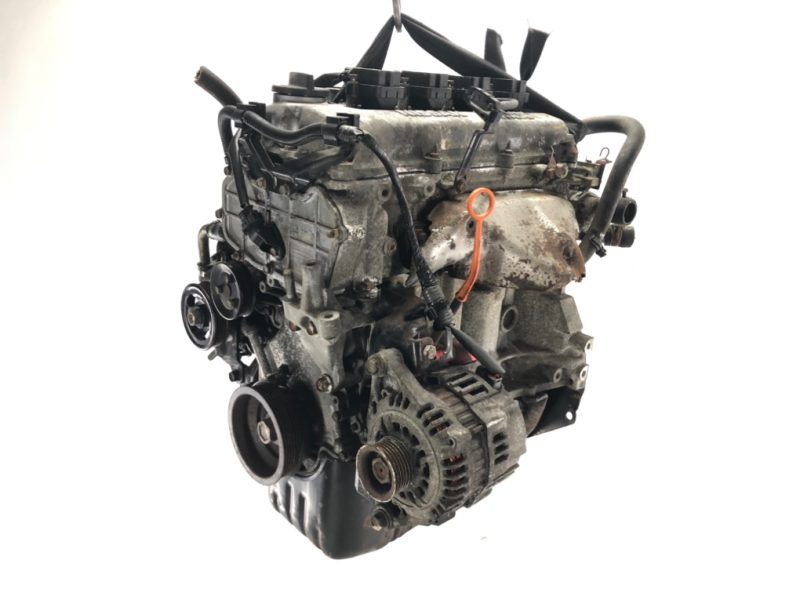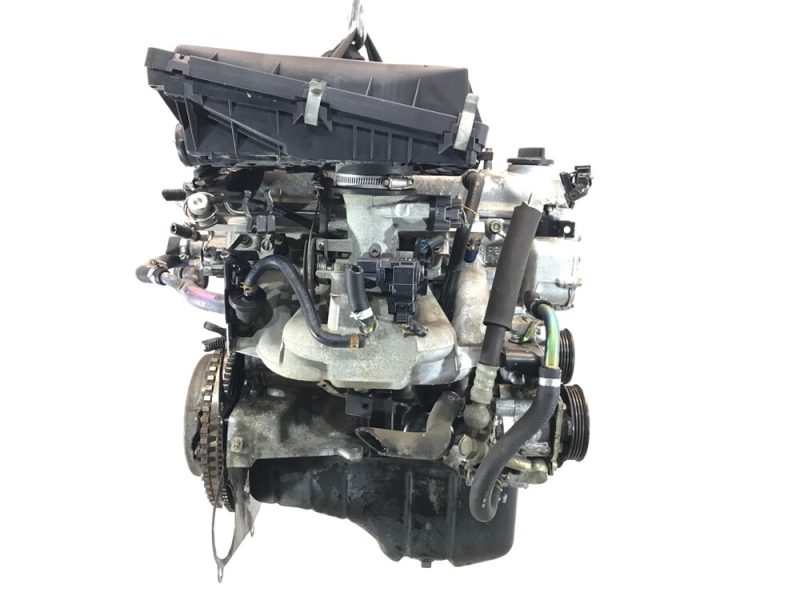Small cars have corresponding engines. And under the hood of Nissan Micra fits the “atmospheric” 1 liter of the line CG, presented besides it also 1,3-liter motor.
Despite the modest dimensions CG10DE is made responsibly. 4 cylinders are located in a 16-valve BC made of aluminum. The timing is driven by 2 chains. This engine has an Eastern variant. Both were produced in 1992-2003. Initially, the motor had a power of 54 hp. But after restyling in 2000, the power increased to 60 hp.
Technical characteristics of the motor Nissan CG10DE 1.0
The Nissan CG10DE engine is a compact gasoline motor that was used on small cars such as the Nissan Micra (March). Its simplicity, reliability and economy made it a popular choice for city cars. Let’s take a closer look at its main technical characteristics and design features.
Main Features
| Characteristics | Value |
|---|---|
| Exact volume | 998 cm³ |
| Power System | Distributed injection |
| Power | 55 – 60 hp |
| Torque | 79 – 80 Nm |
| Cylinder block | Aluminum, R4 |
| Cylinder head | Aluminum, 16 valves |
| Cylinder diameter | 71 mm |
| Piston stroke | 62 mm |
| Compression ratio | 9.5 to 9.8 |
| Engine features | No |
| Hydrocompensators | No |
| Transmission timing | Two chains |
| Fasoregulator | No |
| Turbocharger | No |
| Oil volume | 3.1 liters (5W-30 recommended) |
| Environmental class | Euro 2/3 |
| Example service life | 200,000 km |
| Engine weight | 90 kg |
Structure and features
Cylinder block and block head
The CG10DE engine features an aluminum cylinder block with four cylinders (R4) and an aluminum block head with 16 valves. The aluminum components make the engine lightweight, which has a positive effect on the vehicle’s weight and fuel efficiency. The cylinder diameter is 71 mm and piston stroke is 62 mm, which ensures balanced performance and low vibration.
Power and torque
The CG10DE produces 55 to 60 horsepower and torque in the range of 79-80 Nm. This is quite sufficient for passenger cars designed for urban use. Small size and weight of the engine (90 kg) contribute to its high maneuverability and controllability in dense urban flows.
Operation and life
The average life of the CG10DE engine is about 200,000 km with proper maintenance. It is recommended to use engine oil 5W-30 with a volume of 3.1 liters, which helps to maintain its stable operation and durability.

The engine is not equipped with turbocharger and phase control, which makes its design simpler and more reliable. The lack of complex systems also makes repairs and maintenance easier.
Environmental Standards
The CG10DE meets EURO 2 and EURO 3 environmental standards, which is sufficient for city cars of the 1990s and early 2000s. While this engine doesn’t boast the most stringent environmental ratings by today’s standards, its modest displacement and fuel economy help minimize harmful emissions.
Reliability issues with the CG10DE engine
In general, the engine “Nissan Micra” is characterized by reliability, although it has its own problem areas. Major breakdowns, as a rule, occur not earlier than after 20 years of work and as a result of untimely maintenance.
Problems with starting at low temperatures
This trouble is typical for CG10DE even at temperatures close to zero. The problem can be solved by disconnecting the gasoline pump even before turning the ignition key by pulling the fuse from the CU. The engine will start easily. After starting, the fuse is inserted back into the socket. And some car owners even install a separate toggle switch in the circuit.
To start this engine in the cold will help and clean the idle speed regulator, which sometimes jams. The procedure is simple, and is carried out with an appropriate tool.
One of the causes of problems with starting in the frost may be excessive restriction of the CU air supply during startup. Filled cylinders do not allow the motor to start. The most effective is to install an additional resistance in the circuit of the temperature sensor. Then the information about the temperature of the motor is forcibly overestimated. The automaker has even produced a special cord. They connect the sensor and the control unit.
It happens that CG10DE does not start at night freezing of moisture in the catalytic converter if it is clogged, which clogs the exhaust system.
Difficulties at normal temperatures
If the CG10DE does not start at any temperature, the cause may be a clogged gasoline pump screen or injectors.
On cars with automatic transmission, it happens that the engine does not even turn the starter. The gearbox selector should be checked. After stopping the car, it may not be in the extreme position.
Leaks
The age of CG10DEs in service today affects the various seals. Oil can leak from under the valve cover, leak through the plug hole glands, pressure sensor, timing cover. On non-modernized motors, leakage through the trampler gasket is common. Oil clogs its optical sensor, causing the engine to stall when driving.
Generator
This motor has no special problems with the alternator, however, after a long operation, the bearings wear out. Replacement is required.
Injector clogging
If the injectors are clogged, there are floating revs, trolling, engine stopping when idling. A symptom of faulty injectors is also an increase in fuel consumption.

If one of the injectors is clogged, only three cylinders will work at any speed. It is not difficult to understand which of the injectors does not inject fuel. The plugs are switched off one by one. If, when disconnecting one of them, the tethering has not changed, then the corresponding injector is defective.
Trambler
Problems with the trambler are mainly found on engines manufactured before 2000. The winding is punctured, and the spark is lost. A complete replacement of the part is required.
Throttle valve
The CG10DE throttle valve is a whole assembly with an idle speed regulator and a thermal valve with a fuel flow sensor. In case of floating or increased idle speeds, it will require cleaning. Carrying out the procedure, special attention should be paid to the air sensor, so as not to damage its thread.
Having returned the node to its place, it is “taught” by a simple “game” with the ignition switch.
Thermostat
The thermostat on the motors “Nissan Micra” can be conditionally attributed to the category of consumables. It requires replacement every couple or three years. Approaching breakdown of the thermostat is indicated by wedging and hanging of the motor. The result can be overheating or cooling at high speeds and, as a consequence, expensive repair. The cover is sealed with sealant.
Pompa
This part of CG10DE is difficult to call super reliable. It often fails, which is manifested by noise and antifreeze leaks.
Transmission timing chains
Chains are one of the main weaknesses of CG10DE because of their susceptibility to stretching. The lower chain is stretched more often. Chain stretching is indicated by rumbling. And its consequence can be a reduction in engine power.
BC head
With many years of operation of CG10DE, the oil sealing caps are observed. Oil burns more intensively, settling on the valves. Heat dissipation is impaired and valves may burn out. The BC head is often cracked during long-term operation.
Valve adjustment
Due to the absence of hydrocompensators in CG10DE, periodic checking of valve clearances and their adjustment is required. Often, when diagnosing problems with the engine, clearances are not given due attention. But when they increase at high speeds, there is a drop in engine power.
Adjustment of valves is carried out with the help of washers of 50 sizes.
Enlarged oil consumption
The problem occurs due to a clogged valve of the crankcase ventilation system or oil rings.
Oil consumption can be normalized by cracking them or replacing the ring in CG10DE with one repair size.
